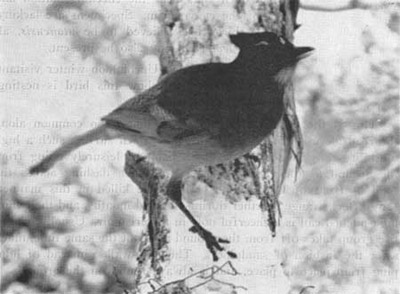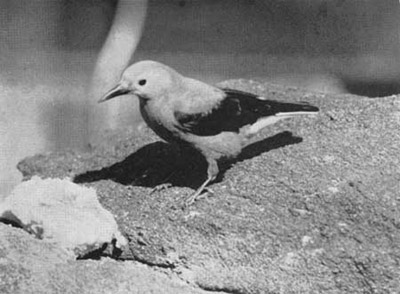|
ZION, BRYCE CANYON, CEDAR BREAKS
Birds of Zion, Bryce and Cedar Breaks |

|
Zion-Bryce Museum Bulletin
Number 5
THE BIRDS OF ZION, BRYCE, AND CEDAR BREAKS
DESCRIPTION OF SPECIES
(continued)
| VIOLET-GREEN SWALLOW (Tachycineta thalassina lepida). | |
| Field Marks: |
Sparrow size. Adults, upper parts mostly greenish; rump violet; wings and tail dark; under parts white, the white extending almost entirely over the rump. |
| Occurrence: |
ZION. Common summer resident around the cliffs. Nests in June and July. CEDAR BREAKS. Common early summer resident around the canyons and rim. Nests in June, and apparently leaves the region in late August. |
|
There is no other bird in the region with such grace in flight as the swallow. High in the air around the cliffs it drifts along with such effortless motion that it seems to be flying for the sheer joy of living. Sometimes it swings along just above the ground, or above some stream, as it searches for food. It nests in cavities in trees, or in crevices in the cliffs. At Bryce it is especially common around the Sunset Point area, and nests in the broken walls below the point. | |
|
| |
| LONG-CRESTED JAY (Cyanocitta stelleri diademata). | |
| Field Marks: |
Large robin size. Adults, coloration bluish; head and long crest black. |
| Occurrence: |
ZION. Common permanent resident, living in the higher parts of the park in the summer, but often coming into the canyons during the cold months. BRYCE CANYON. Common permanent resident throughout the entire park. CEDAR BREAKS. Common summer resident, usually becoming very numerous during the late summer. |
|
There is no mistaking this bird for anything but a jay. Its harsh, scolding call, as it tells the world of your presence, could belong to no other type of bird. He is a noisy fellow, very inquisitive, and entirely too familiar to suit many campers. His lack of fear of man makes him relatively easy to tame. He is well known for his "ladder climbing," as he starts from the lower branches of a tree and hops rapidly to the top. He loves to play pranks on his neighbors, and often scares other birds and small mammals into a wild dash for cover by so cleverly imitating the scream of the Red-tailed Hawk as to fool the listener. Sometimes it apparently tries to sing, and, astonishingly enough, it can produce a series of liquid, pleasant sounding notes that would do credit to many a feathered songster. This is the only jay with a crest found between the Sierra Nevada range and the Rocky Mountains. | |
| WOODHOUSE'S JAY (Aploelocoma coeruluscens woodhouse). | |
| Field Marks: |
Large robin size. Adults, head, wings and tail blue; back brownish; under parts dull gray; throat and upper breast whitish. |
| Occurrence: |
ZION. Common permanent resident throughout the middle and lower elevations of the park. Nests in May and June. BRYCE CANYON. Common summer resident in the lower portions of the park. |
|
This is one of the three crestless jays found in the region. It is a dweller of the oaks and pinon pine-juniper forest. In flight it has a habit of flapping its wings rapidly for a few times, then sailing with stiffly spread wings and tail to its perch—the tail up thrust at an angle from the body. On the ground it usually jerks its head once or twice upon alighting, and hops from place to place—characteristics that are quite different from its cousin and neighbor, the Pinon Jay. While not as noisy as the Long-crested Jay, its harsh cries eliminate any doubts as to its family. Like most jays, it creates havoc among the young of other birds during the nesting season. | |
| AMERICAN RAVEN (Corvus corax sinuatus). | |
| Field Marks: |
Seagull size. Adults, entirely black; Appearance is like that of a crow, but larger. |
| Occurrence: |
ZION. Common permanent resident throughout the park; becomes somewhat scarce during the winter months, except in the lower portions of the park. BRYCE CANYON. Fairly common permanent resident. |
|
This is one of the most playful of all birds in flight-dipping. soaring and diving through the air just for the joy of living. Often it will simply close its wings and fall through space at a dizzy pace, only to open them and sky-rocket upward with amazing dexterity. All the while it gives a series of hoarse, croaking calls, quite different from the cawing of its near relative, the crow. Often it may be seen along the road, where it feeds on rabbits and small ground squirrels killed by automobiles. It is as awkward on the ground as it is graceful in the air, and as it hops clumsily from place to place it seems to have difficulty in controlling and balancing its heavy body. | |
| PINON JAY (Cyanocephalus cyanocephalus) | |
| Field Marks: |
Robin size. Adults, all blue. |
| Occurrence: |
ZION. Fairly common permanent resident throughout the pinon pine-juniper belt. BRYCE CANYON. Fairly common permanent resident in the lower reaches of the park. |
|
The plump body, short tail and uniform color help to distinguish this jay from the other two crestless varieties found in the region. This is a social bird, often joining with others to form large flocks during the colder months. While it does do a lot of "talking" while in a group, it is not to be considered a really noisy jay. Unlike most jays, this bird is often found feeding on the ground, where it walks around in crow fashion. | |
|
| |
| CLARK'S NUTCRACKER (Nucifraga columbiana). | |
| Field Marks: |
Crow size. Adults, body light gray; black wings with large white patches; tail white, except for the middle feathers, which are black. |
| Occurrence: |
ZION. Uncommon winter visitant in the higher portions of the park. BRYCE CANYON. Fairly common permanent resident, although seldom getting into the lower portions of the park. CEDAR BREAKS. Common permanent resident. |
|
This is a bird of the high mountains, although often wandering into the lower elevations during the winter months. Its general crow-like shape has earned it the name of "Clark's Crow" in many localities. Unlike his darker relative, however, he is far from being alarmed at the presence of man, but will often perch himself on a prominent limb in the top of a tree and tell the world of his presence. During the fall and early winter months, this bird joins with others of his kind in large flocks. He is a restless fellow, and seldom stays very long at one spot. | |
| MOUNTAIN CHICKADEE (Parus gambeli gambeli). | |
| Field Marks: |
Wren size. Adults, grayish, with a black cap and chin; white line over each eye. |
| Occurrence: |
ZION. Common permanent resident in the higher portions of the park, but is infrequently seen in the canyon except during the winter months. BRYCE CANYON. Common permanent resident throughout the area. CEDAR BREAKS. Common permanent resident throughout the region. |
|
Without doubt this is one of the best loved birds of the entire region. His cheery song is heard from the cool depths of the fir and aspen forests, while his "oh, dear me" helps to revive the drooping spirits of many a tired hiker on the trails. An agile acrobat, he is as much at home upside down as right side up. He seems to have absolutely no cares or worries of any importance, but drifts blithely through the forest in a ceaseless search for food. He is quite sociable, and is often found with others of his kind in large groups in the fall of the year. His nest is usually found in some old cavity in a tree, and is lined with fur, if such can be found. | |
| GRAY TITMOUSE (Parus inornatus griseus). | |
| Field Marks: |
Wren size. Adults, plain gray, with a prominent crest. |
| Occurrence: |
ZION. Fairly common permanent resident in the pinon pine-juniper belt, much commoner in the summer than in the winter months. BRYCE CANYON. Uncommon summer resident in the lower portions of the park. |
|
Because of its plain coloration and unassuming song, the Titmouse is often overlooked by visitors. Yet, in his quiet way, he is one of the most interesting and agreeable birds in the region. The Titmouse family is a joy to watch. The parents entice the young from the nest, and then the entire family moves slowly through the trees and brush in search of feed, with the young being constantly guided by the cheerful calls of the parent birds. | |
| LEAD-COLORED BUSH-TIT (Psaltriparus minimum plumbeus). | |
| Field Marks: |
Small wren size, Adults, plain gray; rather long tail for the size of the bird. |
| Occurrence: |
ZION. Fairly common permanent resident, being especially numerous during the winter and spring months. Nests in May. BRYCE CANYON. Uncommon summer visitant in the lower reaches of the park. |
|
This tiny feathered mite is a familiar sight among the bushes on the canyon slopes and along the valley floor. One will see a shower of tiny forms drift from one bush to another bit of shelter, then another and another, until one wonders if there is ever going to be an end to the procession. Talking and tittering in a low voice as they go, the Bush-Tits industriously search every nook and cranny of each branch for food. They show little fear of man, and will come within a few feet of an observer, close enough, in fact that one can almost reach out and touch them. Only during the nesting season are these birds to be found in pairs; the rest of the year they range in large groups through the region. | |

